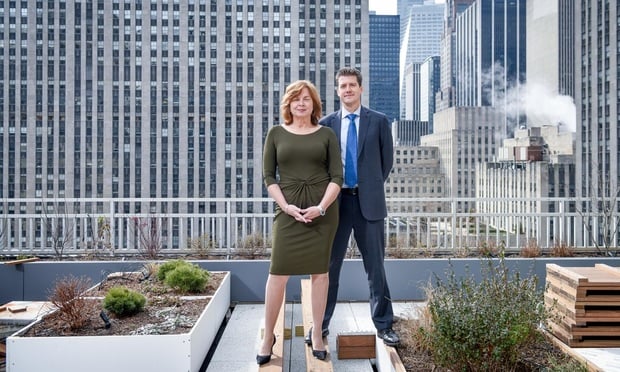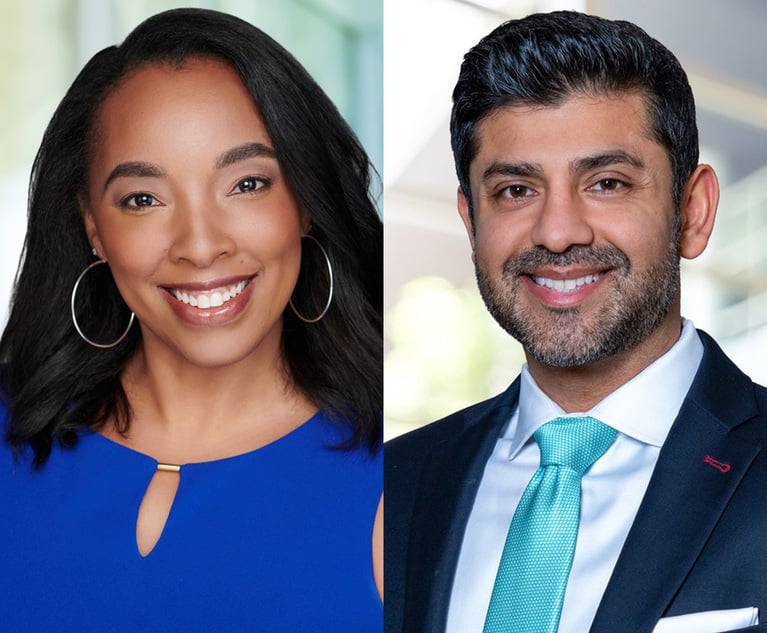At Selendy & Gay, One Year Tells the Tale of a Big Law Spinoff
After breaking off from Quinn Emanuel Urquhart & Sullivan last winter, Selendy & Gay is eschewing the Big Law model.
February 27, 2019 at 05:00 AM
12 minute read
 Faith Gay and Philippe Selendy, the name partners of Selendy & Gay in New York City. (Photo by David Handschuh/ALM)
Faith Gay and Philippe Selendy, the name partners of Selendy & Gay in New York City. (Photo by David Handschuh/ALM)
In Selendy & Gay's earliest days, before the firm had moved into its office space near New York City landmarks like Rockefeller Center and Radio City Music Hall, its founding partners couldn't meet potential recruits in the sunlit conference rooms they now use. They couldn't show off the artwork that adorns the firm's hallways a year after its launch last February. There were no stately boardroom tables to sit at as they made their pitches.
Instead, they found a more personal venue.
Although the partners met some associate candidates in restaurants, much of the firm's early recruiting happened in the living room of Philippe and Jennifer Selendy's Upper West Side residence, with interviews on couches and strategy mapped out around the kitchen table. The husband and wife duo comprise half of Selendy & Gay's top brass, alongside Faith Gay and David Elsberg—Philippe Selendy and Gay are the firm's namesakes, while Jennifer Selendy and Elsberg serve as co-managing partners.
The four founding members had high expectations for the younger lawyers the newly launched firm could attract. Given their stature, those hopes weren't unrealistic—they had all burnished reputations as top litigators before leaving Quinn Emanuel Urquhart & Sullivan in early 2018. Still, hiring isn't a sure bet, and it would be hard to blame a promising young lawyer for pursuing an early-career job at a more established firm in Big Law, as opposed to helping build a brand-new firm.
“You have law students coming in, or young associates coming in, looking around, and we're basically saying, 'Trust us, we'll have an office,'” Elsberg says.
But if the lack of a physical office deterred any potential recruits at the outset, they may have been drawn back in by the firm's guiding principles: measured growth driven by hiring top-notch associates, training them at a high level, and keeping them for the long haul.
Selendy & Gay's leaders also stress diversity—the firm is majority-owned by women—and its work on a range of litigation matters on the plaintiffs and defense side, including pro bono cases and matters involving public-private partnerships, in a vein reminiscent of Philippe Selendy's past work for the Federal Housing Finance Agency. In those FHFA cases, Selendy, then at Quinn Emanuel, represented the agency as the conservator for Fannie Mae and Freddie Mac, helping the government secure more than $25 billion from financial institutions involved with the mortgage-backed securities that triggered the 2008 financial downturn.
In many ways, the Selendy & Gay approach can be seen as a re-examination of the Big Law model, where firms increasingly resemble the behemoth corporations they often count as clients. On one level, the firm's founders have opted for an approach that harkens back to a past when more law firms were truly partnerships—their vision is to keep everyone within a single office to increase collaboration and to refrain from growing too large, even if that means turning away work.
“There was a sense in which big law firms had in some ways lost their way by being too big, by being global, by publishing their profits per partner, by having constant lateral partner hiring,” Jennifer Selendy says. “We were looking in many ways to create a firm that could correct some of those things.”
With that vision in hand, the firm's partners left Quinn Emanuel last winter and waded into the relatively small world of Big Law spinoffs, joining Wilkinson Walsh + Eskovitz, started in early 2016, and the firm now known as Kaplan Hecker & Fink, which started in 2017.
While leaders at spinoff firms tend to hold similar ambitions in the early stages—breaking the traditional big firm mold and eschewing the billable hour model, taking on work that truly interests them and devoting attention to training an up-and-coming generation of younger lawyers—they've followed different paths. Boies Schiller Flexner, for instance, started in 1997 with former Cravath, Swaine & Moore partner David Boies and former Kaye Scholer partner Jonathan Schiller. It has since grown into a firm of more than 300 lawyers. Meanwhile Bartlit Beck, started in 1993 by Kirkland & Ellis expatriates, consciously chose to remain small, even turning away work and merger offers to do so.
A year into their own spinoff, Selendy & Gay's leaders say they're on solid ground, with a strong group of associates, plentiful work and an office space set to receive its final touches. But how did they get to this point, and what's next?
Avoiding Pitfalls
Law firm consultants say that, in general, the small spinoff or boutique model offers a robust business opportunity. Firms like Selendy & Gay can take advantage of new technology and staffing agencies to bring on temporary contract lawyers when a litigation matter enters an all-hands-on-deck period, while staffing leanly at other times. And all of the lawyers on a given team tend to be at the top of their game.
“If you choose the boutique, you're only going to get the A team,” Bruce MacEwen of Adam Smith Esq. says. “There is no B team.”
But with the spinoff's advantages also come a specific set of challenges. MacEwen and his Adam Smith Esq. colleague Janet Stanton say that for many small spinoff firms, the toughest moment comes later, when the time comes for founders to hand over leadership duties to a new generation. Selendy & Gay, of course, is years away from that particular quandary, but a small-firm model also can present obstacles at its early stages.
“Successful smaller firms have to reduce the administrative onus on the partners,” Stanton says. “You want to free them up to practice law.”
Since its launch, Selendy & Gay has made an effort to shield its business drivers—the partners—from the management side of the firm. It's had a chief operating officer since day one and recently added a chief financial officer and chief marketing officer.
“We put together a business team that can really handle a tremendous amount for us, reporting to us so we can oversee it. But the idea was that we were going to make sure that we didn't proliferate management and bureaucracy issues for ourselves—let the business be run by business people and let us continue to generate revenue,” Jennifer Selendy says.
As the firm matures, it will have to come to grips with the reality of its approach to growth, says Altman Weil law firm consultant Eric Seeger.
“When you grow quickly to, say, 30 lawyers, then you have to start thinking about, 'How do we manage this place, where and how and what do we grow, and who takes the lead in facilitating the growth?'” he says.
There, too, it seems that Selendy & Gay's leadership have thought through the impact that their growth ambitions—which include getting up to somewhere between 100 and 150 lawyers—might have on the collaborative culture they're seeking to hang onto.
“If you imagine a future meeting where we are at 150 lawyers, and there was an opportunity to grow into a different area, I think you would find an uproar among the partners,” Jennifer Selendy says. “Why would we jeopardize that quality of the firm?”
Both of the firm's founders, Philippe Selendy and Gay, say that Jennifer Selendy's ownership of planning out the business side of the firm was instrumental in helping free up the rest of the firm to do what it does best: litigate.
“Philippe and I had our head in the clouds—like, 'Oh what's the next theory we want to bring a case on?'” Gay says. “Jennifer was like, 'You must have a good infrastructure so that people are happy from day one.' And you know what? She was totally right.”
Re-Envisioning the Modern Firm
To hear its founders describe it, almost every detail of Selendy & Gay's design focused on building a culture in line with the founders' values, and on keeping that culture intact over time. They've even focused on little things—partners' offices are all the same size; associates and partners sit and work at large tables together to eliminate a sense of rigid hierarchy—to help foster the kind of collaboration they want to maintain.
For his part, Philippe Selendy takes on the tone of a proud parent while discussing those details. On a recent walk through the two floors that make up the Selendy & Gay office on the Avenue of the Americas, he noted the firm's art collection—highlighted by pieces from Mexican artist Gabriel de la Mora—and talked about future gatherings on an outdoor terrace. (He also joked about taking associate candidates, particularly those coming from a southern climate, out onto the 17th-floor terrace in mid-winter to see what they're made of.) He dipped into the gym that's been installed on the office's second floor, replacing what was once a high-density storage room that's no longer needed because the firm backs up information on the cloud.
High art and an employee gym aren't, in the strictest sense, necessary for a 32-lawyer office. But they're small touches that symbolize two of the firm's goals, Selendy says. One of them: “Invest now, because we intend to be around for a very long time.” The other: provide ample opportunity for the firm's employees to engage with one another.
“That's a surprisingly important virtue of the firm. Just being here physically present in a single office; being able to walk down the hall, meet people many times a day and share ideas—things happen much more naturally,” Selendy says. “It's a better way to practice.”
Hiccups, Not Roadblocks
Even though they view the firm's first year as overwhelmingly successful, Selendy & Gay's leadership did admit that not everything went according to plan. Still, the troubles they ran into were more like hiccups than massive obstacles, they say.
Although the firm's leaders didn't mention it as a specific challenge, the founding group's departure from Quinn Emanuel met with some turbulence. Even before they had departed, Quinn Emanuel founder John Quinn alerted the public that a group of partners in New York, led by Gay and Philippe Selendy, planned to leave and start their own firm. That might have stolen a bit of thunder from Selendy & Gay's official launch a little more than a month later in mid-February, but it was also a precursor to an ongoing legal battle between Quinn Emanuel and the lawyers who went on to found Selendy & Gay.
As of press time, the two sides are arguing over a provision in the Quinn Emanuel partnership agreement that purports to entitle the firm to a cut of fees that the Selendy & Gay lawyers earn on matters they took with them from their old firm. In broad terms, Selendy & Gay has maintained that the provision runs afoul of legal ethics rules, while Quinn Emanuel has been pushing to get the dispute out of court and into private arbitration.
Asked about the ongoing dispute, Philippe Selendy notes his partners' contributions to their prior firm. Far from a rebuke of their former colleagues, he says, the new firm can be seen as an extension of the founders' ambitions to reassess the Big Law approach to practicing law.
“We were instrumental in helping the firm grow. We spent, some of us, decades or longer with them. When I joined, the New York office was smaller than Selendy & Gay was six months ago. It was very important and very gratifying to help build out the practice areas,” Selendy says of Quinn Emanuel. “We have a number of individuals there that are very close to us and we have a lot of respect and friendship there.”
In a brief email, Quinn downplayed the importance of the dispute with Selendy & Gay. “For us and, I assume, for them, the dispute is not the significant event the press has made it out to be,” he said. “Last year was the best year we have ever had and, by reports, they have done well also. The dispute is only about money and will eventually be resolved one way or another for an immaterial amount.”
Outside of the Quinn Emanuel dispute, however, the issues Selendy & Gay ran up against in its early stages were relatively minor. As one example, Elsberg and Jennifer Selendy describe a period shortly after the firm moved into its current office when the phones didn't work and lawyers had to rely on wireless hotspots to connect to the internet.
“That was a real kick in the head. You don't think, 'Starting this is going to be great, we're going to be using a personal MiFi hotspot,'” Elsberg says.
Philippe Selendy offers another example, related to the firm's office space. When the partners first moved in, a section had to be renovated—what was once a row of associate offices is now a large, bright conference room looking out, on one side, over a terrace that extends off the office's kitchen space. The terrace, however, remains one of the firm's last unfinished construction projects as of early February.
The outdoor flooring is largely in place and a number of small trees have been planted. But, Selendy explains, there's still more landscaping to be done.
Email: [email protected]
This content has been archived. It is available through our partners, LexisNexis® and Bloomberg Law.
To view this content, please continue to their sites.
Not a Lexis Subscriber?
Subscribe Now
Not a Bloomberg Law Subscriber?
Subscribe Now
NOT FOR REPRINT
© 2025 ALM Global, LLC, All Rights Reserved. Request academic re-use from www.copyright.com. All other uses, submit a request to [email protected]. For more information visit Asset & Logo Licensing.
You Might Like
View All
Government Attorneys Face Reassignment, Rescinded Job Offers in First Days of Trump Administration
4 minute read


Energy Lawyers Field Client Questions as Trump Issues Executive Orders on Industry Funding, Oversight
6 minute readTrending Stories
- 1We the People?
- 2New York-Based Skadden Team Joins White & Case Group in Mexico City for Citigroup Demerger
- 3No Two Wildfires Alike: Lawyers Take Different Legal Strategies in California
- 4Poop-Themed Dog Toy OK as Parody, but Still Tarnished Jack Daniel’s Brand, Court Says
- 5Meet the New President of NY's Association of Trial Court Jurists
Who Got The Work
J. Brugh Lower of Gibbons has entered an appearance for industrial equipment supplier Devco Corporation in a pending trademark infringement lawsuit. The suit, accusing the defendant of selling knock-off Graco products, was filed Dec. 18 in New Jersey District Court by Rivkin Radler on behalf of Graco Inc. and Graco Minnesota. The case, assigned to U.S. District Judge Zahid N. Quraishi, is 3:24-cv-11294, Graco Inc. et al v. Devco Corporation.
Who Got The Work
Rebecca Maller-Stein and Kent A. Yalowitz of Arnold & Porter Kaye Scholer have entered their appearances for Hanaco Venture Capital and its executives, Lior Prosor and David Frankel, in a pending securities lawsuit. The action, filed on Dec. 24 in New York Southern District Court by Zell, Aron & Co. on behalf of Goldeneye Advisors, accuses the defendants of negligently and fraudulently managing the plaintiff's $1 million investment. The case, assigned to U.S. District Judge Vernon S. Broderick, is 1:24-cv-09918, Goldeneye Advisors, LLC v. Hanaco Venture Capital, Ltd. et al.
Who Got The Work
Attorneys from A&O Shearman has stepped in as defense counsel for Toronto-Dominion Bank and other defendants in a pending securities class action. The suit, filed Dec. 11 in New York Southern District Court by Bleichmar Fonti & Auld, accuses the defendants of concealing the bank's 'pervasive' deficiencies in regards to its compliance with the Bank Secrecy Act and the quality of its anti-money laundering controls. The case, assigned to U.S. District Judge Arun Subramanian, is 1:24-cv-09445, Gonzalez v. The Toronto-Dominion Bank et al.
Who Got The Work
Crown Castle International, a Pennsylvania company providing shared communications infrastructure, has turned to Luke D. Wolf of Gordon Rees Scully Mansukhani to fend off a pending breach-of-contract lawsuit. The court action, filed Nov. 25 in Michigan Eastern District Court by Hooper Hathaway PC on behalf of The Town Residences LLC, accuses Crown Castle of failing to transfer approximately $30,000 in utility payments from T-Mobile in breach of a roof-top lease and assignment agreement. The case, assigned to U.S. District Judge Susan K. Declercq, is 2:24-cv-13131, The Town Residences LLC v. T-Mobile US, Inc. et al.
Who Got The Work
Wilfred P. Coronato and Daniel M. Schwartz of McCarter & English have stepped in as defense counsel to Electrolux Home Products Inc. in a pending product liability lawsuit. The court action, filed Nov. 26 in New York Eastern District Court by Poulos Lopiccolo PC and Nagel Rice LLP on behalf of David Stern, alleges that the defendant's refrigerators’ drawers and shelving repeatedly break and fall apart within months after purchase. The case, assigned to U.S. District Judge Joan M. Azrack, is 2:24-cv-08204, Stern v. Electrolux Home Products, Inc.
Featured Firms
Law Offices of Gary Martin Hays & Associates, P.C.
(470) 294-1674
Law Offices of Mark E. Salomone
(857) 444-6468
Smith & Hassler
(713) 739-1250










